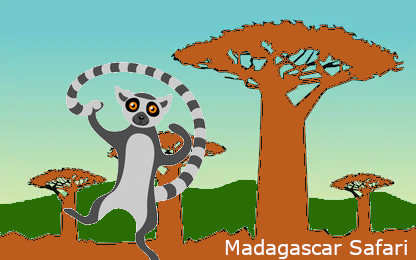- INTRODUCTION
- MALAGASY CULTURE
- MALAGASY TRADITIONAL SPORT
- MALAGASY CUISINE
- BEACHES AND RIVERS
- MONEY AND CREDIT CARDS
- PURCHASE TIPS
- SITES AND ACTIVITIES
- MONUMENTS
- MALASY HANDICRAFTS
- TIPS FOR TRAVELLERS
- MADAGASCAR CONNECTING FLIGHTS
- MADAGASCAR NATIONAL PARKS AND RESERVES
- FAUNA AND FLORA OF MADAGASCAR
- PUBLIC HOLIDAYS IN MADAGASCAR
- THE SOUTH WEST AND WESTERN REGIONS
- THE SOUTH EAST REGION
- THE NORTH WEST REGION
- THE NORTH EAST AND EAST REGIONS
- THE CENTRAL HIGHLANDS
MADAGASCAR: THE NORTH-WEST REGION
Ramena, “the” beach of Antsiranana is 18 km from the city. The Sakalava Bay at PK 13 on the road to Orangea is ideal for fun borders. The emerald sea just outside the false channel, a lagoon which is like an immense natural aquarium. The Bay of Courrier, starting point for a number of water activities (diving, fishing, bivouac)… the Mountain of the French, 8 km from the town, with its caves and fortification remnants. Windsor Castle, if you come from the west,it will offer you a 360° panoramic view on the Cape of Amber to the north, the Mozambique Channel to the west, the Bay of Diego to the east and the Amber Mountain to the south.
From Antsiranana to the south
The Amber Mountain and the Massif of Ankarana, two hotspots for ecotourism and Antakarana traditions. The lake of Anivorano, 75 km away, features crocodiles which are sacred as they are supposed to be ancestors of the ancient times. Ambilobe is where the Antakarana kings reside. Developers’ interests are at present focused on the Bay of the Russians, just opposite Nosy Be, where they want to build new hotel infrastructures.
Antsiranana (Diego Suarez)
Nestling in one of the most beautiful bays of the world, the town lives with the rhythm set by its shipyards, and the legend of libertalia associated with the golden age of freebooting is still in minds. A mosaic of people where white djellabas meet with the multicoloured loincloths of the women who often have beauty mask on their faces. This coastal region, always attentive to the call of the sea, unrolls its beaches and creeks along a slack sea sprinkled with islets that seem to be at the far-east edges of the world. It is not surprising that with such assets, it has pioneered the opening of Madagascar to international tourism. It confirms this specific feature of the great island which is combining the exceptional beauties of the sea and the various attractive poles of interest of the land.
Nosy Be
Nosy Be and its coral islands… in everyone’s mind, it opens up a picture of palm trees and white sand beaches. Nosy Be is more than that. Indeed its privileged geographical position accounts for this image. Apart from its cultural specificity, revealed through its rituals, its fady (taboos), its sacred sites (sacred trees) and its traditional small villages (falafa) scattered all the way, Nosy Be’s historical heritage is extremely rich and has left its imprints on the island (the Prince’s residence, royal tombs)… Some of the rituals practised by the people, the small sailing boats, the Indian village… are marks which immigrants from Comoros, Zanzibar in times of maritime trade in the Indian Ocean left behind them. Other historical events have given their names to some sites (mount Passot, Hell Ville, Bay of the Russians..). Nosy Be, is a beautiful mixture of culture and nature: the immense sea territory and its accessibility offers several possibilities for discovery and recreational activities. Encounters with several species (tortoises, rays, dolphins, whales) are frequent. The destination is famous for its inoffensive whale sharks. The reef surrounding is a real aquarium. Cruises by catamaran, sailing boats or traditional canoe will be for you an opportunity to enjoy tranquility in the immensity of the sea, beaches and desert creeks. As it is in the Mozambique channel, amateurs will have the joy to fish carangue, swordfish, sea breams and other. The land offers great biodiversity. Of volcanic origin, the numerous lakes are bordered with rice fields, raffia and travelers’ trees and are a real home for crocodiles. Crossing the sugar cane, ylang ylang, coffee and vanilla plantations, “Nosy Be, the island of perfumes” gives its summits and ridges for you to enjoy a panoramic view of the region. The forests, the natural reserves in the numerous islets (Lokobe, Sakatia, Komba), each one different from the other, will give you the opportunity to observe the endemic wildlife, its fauna (lemur macaco, chameleon, giant bats, sea eagle…) as well as its tropical flora rich in medicinal plants. Lastly, Nosy Be, it is the twinge of nostalgia at the sight of the richelieu style embroidered curtains which you have chosen with the embroiderers. Nostalgia of what the kindness of its people has given you, to the rhythm of salegy (music) and its colourful cuisine. It will conjure up in your mind like the words of a song: Nosy Be, Nosy sakatia, Nosy tanikely, Nosy Komba, Nosy Iranja, Nosy Mitsio.
From Mahajanga (Majunga) to the south-west
Mahajanga, the second port of Madagascar, situated at the mouth of the Betsiboka, a town marked by remote Indo-Arab influence. Here are several pictures which are really loved by many: the Port of sailing boats, the rehabilitated sea front, the great baobab tree with its more than 20 m circumference, the magnificent sunsets. First destination of domestic tourism. Katsepy, at the entrance of the Bay of Bombetoka, one of the most beautiful beaches of Mahajanga, the Bay of Baly, magnificent scenery which will take your breath away. The Lake Kinkony, a 15 000 ha of water in the heart of the plains of Mahavavy.
From Mahajanga to the north
The red Cirque (3 km), an amphitheatre shaped by erosion where the layers play with the glints of the sun. Between Ampazoana and Antsanitia is a beautiful coastline which is going to be a key element of Mahajanga tourism.
